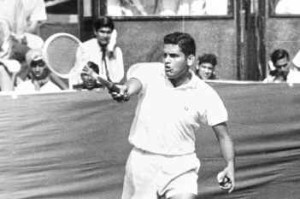Registered with the Registrar of Newspapers for India under R.N.I 53640/91
Uncategorized
He put India on the world tennis map
Partab Ramchand remembering Ramanathan Krishnan at 80
Ramanathan Krishnan, India’s tennis great, turns 80 on April 11th and I hope this article helps us to recall his outstanding feats in the 1950s and ’60s that have still not been matched.
Indian tennis had a brief moment of glory internationally before the advent of Krishnan, when Ghaus Mohammed entered the men’s singles quarter-finals at Wimbledon in 1939 before losing to the ultimate champion Bobby Riggs of the USA. But it was Krishnan’s arrival that made the tennis world really familiar with India.
 Ramanathan Krishnan.
Ramanathan Krishnan.
The first feat that made him nationally known was winning the Stanley Cup at the Bertram tournaments conducted by Loyola College. It was an event for college boys and Krishnan became the first schoolboy to win it at the age of 13 in 1950. Under the tutelage of his father T.K. Ramanathan, himself a player of national repute, Krishnan made giant strides and the next step towards greatness was becoming the first Asian to win the Junior Wimbledon title in 1954, a feat his son Ramesh repeated in 1979.
Krishnan’s upset victory over Jaroslov Drobny, the 1954 champion, in the very first round of the 1956 Wimbledon made the tennis world really sit up and take notice of a potentially world class player from India. And for the next decade he carried Indian hopes at both Wimbledon and in the Davis Cup. At Queen’s Club in 1959 he won the title beating Alex Olmedo of the USA in what was a curtain raiser for Wimbledon – in which the American was the top seed. Later that year, Krishnan got the better of Wimbledon runner-up Rod Laver in the Davis Cup inter-zone final against Australia. By then he was ranked among the world’s leading players.
Indeed, around this time, Jack Kramer offered Krishnan big money to turn pro and join his pro circuit. Krishnan however turned down this offer, for to him, playing Wimbledon and Davis Cup were sacred and joining Kramer’s group would have prevented him from playing in these tournaments. The offer remained open for three years and his refusal surprised Kramer, but Krishnan never regretted his decision.
A historic moment came about in 1960 when Krishnan became the first Indian to enter the men’s singles semi-finals at Wimbledon. He went down to the ultimate champion, Neale Fraser of Australia. The following year, Krishnan again made it to the last four, only to lose to another ultimate champion Laver. In 1962, Krishnan was seeded No. 4 behind the three Australians, Laver, Fraser and Roy Emerson, but had to concede his third round match to John Fraser, brother of Neale, because of an ankle injury. The following year he made it to the fourth round before losing to Emerson.
Krishnan was never again a force to reckon with at Wimbledon, but continued to be a feared opponent in the Davis Cup where he regularly made sure that India made it to the inter-zone final and finally, in 1966, most memorably, to the Challenge Round against Australia. It was Krishnan who made this historic moment possible. The inter-zone final against Brazil at Calcutta was tied at 2-2 when Krishnan scored a brilliant comeback win over Brazil’s leading player Tomas Koch to ensure India’s victory. Koch was leading by two sets to one and 5-2 in the fourth only for Krishnan to reel off nine games on his way to taking the last two sets 7-5 and 6-2.
It was not just the results that made the tennis world sit up and take notice of Krishnan. It was his style of “touch tennis” that attracted considerable attention. Lance Tingay, the well known British tennis writer, described Krishnan’s game as “pure Oriental charm” and “Eastern magic”. More recently, Robert Philip wrote that “each and every Krishnan rally was a thing of rare beauty.” Krishnan’s serve was never a powerful weapon, but measured ground strokes, a backhand that was a joy to watch, and angled volleys made him an opponent to be feared. His game was most eloquently described by Duncan Macaulay who witnessed Krishnan’s defeat of Emerson in the Wimbledon quarter-finals in 1961. “Most surprisingly Krishnan beat Emerson with absolute ease. This was one of the best matches that Krishnan ever played at Wimbledon. He turned Emerson’s speed to his own advantage and directed his shots with a magical caress to those points of the court where Emerson wasn’t.”
A recipient of the Arjuna Award in 1961, the Padma Shri in 1962 and the Padma Bhushan in 1967, Krishnan, after his playing days were over, was non-playing captain of the Davis Cup squad for several years and now with son Ramesh runs the Krishnan Tennis Academy in Kottivakkam. But it is his feats as a pioneering and inspiring tennis great for which he will be most fondly remembered, paving the way for the likes of, first, Premjit Lal and Jaideep Mukherjea and then the Amritraj brothers, Vijay and Anand, son Ramesh and Leander Paes, to keep India’s challenge going at international events.

